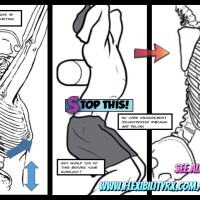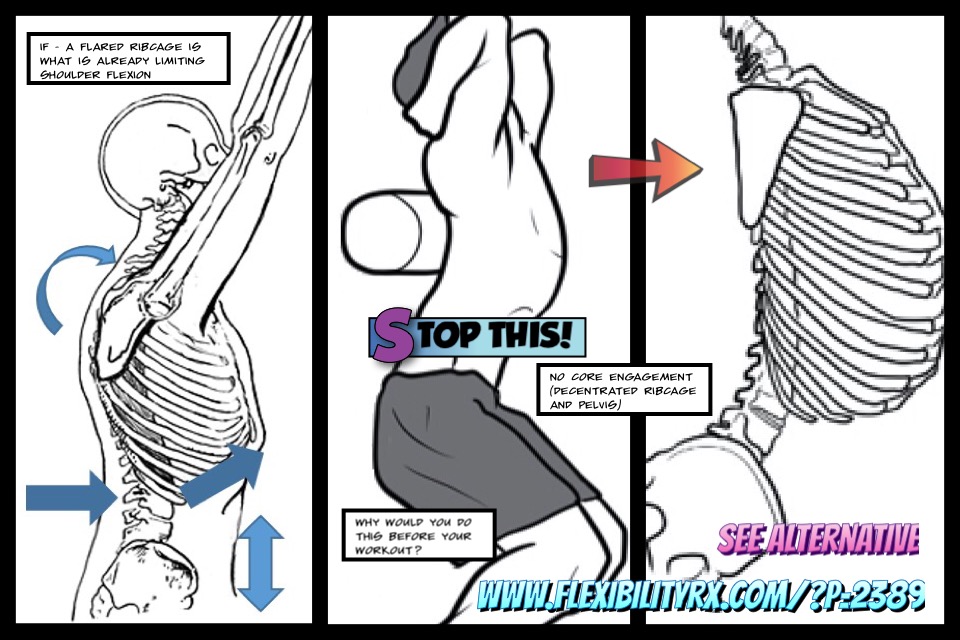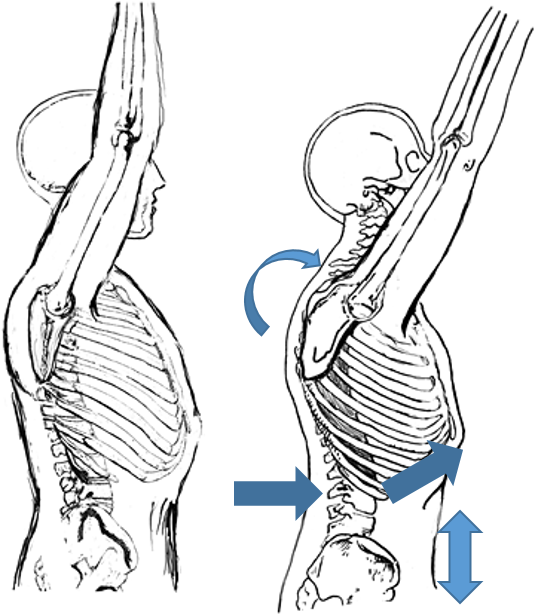
I personally would have no problem with a patient telling me that they use a foam roller on their thoracic spine. Rolling back and forth (horizontally), relaxing with it lengthwise along their spine to open the chest, or even some typical extensions mid thoracic. Kudos to them – they took some initial to work on their mobility.
What I do have a problem with is the following situation:
An athlete is getting ready for their workout (who tells me that their overhead mobility is limited and they are going to be pressing overhead) and they proceed to get on the foam roller and begin doing thoracic ‘extension’ exercises that flare their ribcage and over arch their low back.
This is partially a question of who should be doing that exercise – someone that is already flared in their ribcage should not be further flaring their ribcage pre-workout.
If someone is neutral in their spine and ribcage orientation – I still think there are better ways to prepare the thoracic spine to achieve the extension needed for overhead lifts.
The important consideration here is that a flared ribcage is what commonly limits overhead range of motion. Priority number one should be to engage the abdominal obliques to secure the ribcage down into a stable position.
This way the spine can extend from a neutral position and the shoulders can obtain full flexion overhead. If the ribcage is stuck forward/up/out then the spine is not neutral and the ribcage needs to be reset BEFORE we talk thoracic spine.
If you read my post on the downward dog alternative you may be thinking that I am not a fan of the traditional downward dog. While I do not condone hamstring stretching on it’s own (as it is generally a misinterpretation of neurological input and tends to appeal to people that are already overstretched or not neutral in their pelvis) I have no problem with a patient of mine who regularly practices yoga taking their body through a full range of motion.
IF…
They can obtain neutrality of their pelvis and ribcage and are not patterned into a rigid position. Ida Rolf had a great saying regarding the alignment and stabilization of the body,
“In a human body, support is not something solid. Support is relationship. Support is a balance of elements that aren’t solid at all, elements that are incapable of withstanding the weight that presses down on them except as they are balanced.”
Neutrality is the ability to disengage muscular chains throughout the body so that we can alternate from our left side to our right side in the frontal plane as we advance forward (locomote). Our right adductor has to disengage as our left adductor pulls us over to the left – one muscle is engaging as the other muscle is disengaging.
Someone that is patterned into their right side – too stable on their right leg – is not going to be neutral in their pelvis. Their pelvis will be rigidly held into a misalignment because they cannot let go and conversely find and feel antagonist muscles.
Here we are considering the neutrality of the ribcage. Shoulder flexion in the sagittal plane requires a certain level of disengagement of the hip flexors and low back to allow for normal lumbar lordosis and thoracic extension.
The deep hip flexor (psoas) attaches to the diaphragm and will malposition the spine if an athlete cannot exhale the ribs down by finding and feeling their obliques.
The abdominal obliques need to engage to hold the ribcage in place so that the spine can extend and the shoulder blades can rotate around a fixed ribcage.
While thoracic extension exercises on a foam roller may be appropriate for some athletes here are three problems…
Three Problems with Thoracic Extension on a Foam Roller
#1: Targeting the Spine While Neglecting Ribcage Position
#2: Lack of Core Engagement/Neurological Priming of Position
#3: Further Imprinting of an Overextended Posture
The athlete that has been sitting all day and has just driven to the gym (more sitting) needs to prime their body for overhead movement.
Here is an alternative (Supine Hooklying T8 Extension) from the Postural Restoration Institute
Thanks to PRI Practitioner Ryan Dobbeck of Dobbeck Training Systems for helping me with this video.
The restoration of position involves a cycle of breathing that first requires an exhalation to fix the ribcage down into a position of internal rotation. From that fixed position, the inhalation helps to expand the intercostal space of the ribcage.
The exhale sets up the inhale.
The important point is not to flare the ribcage on the inhale – keep the exhalation position as you inhale. The arms then reach on the inhale to help mobilize the thoracic spine. The hamstrings secure the pelvis while the serratus anterior retracts the ribcage as the arms reach.
The serratus anterior is not just a scapular protractor – it is a retractor of the ribcage. Serratus anterior’s role in securing the ribcage is an essential component of overhead motion.
Exhaling the ribcage down and holding that position while inhaling is a very different training of the abdominals than crunching forward on the roller then relaxing back into extension. The goal here is to use 4-5 breath cycles to restore the dome shape and pumping action of the diaphragm. Crunches will not accomplish that intention.
This positional breathing drill will reset the shape and function of the diaphragm which will down regulate an overactive psoas. Don’t forget that the psoas/diaphragm connection to the spine right around T8 has major implications for thoracic spine mobility. I’m not saying to throw out your foam roller – I’m asking athletes to show the diaphragm some respect! Let’s dome the diaphragm – then get out your roller.
– Kevin J. Kula, “The Flexibility Coach”


Leave A Reply (No comments so far)
You must be logged in to post a comment.
No comments yet